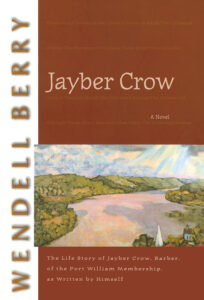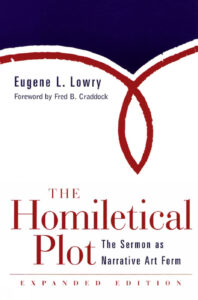Matt’s Shelf

Jayber Crow
by Wendell Berry
Set in rural Kentucky, in a town called Port William, nestled by the Kentucky River, Jonah Crow (later nicknamed Jayber) becomes an orphan at an early age. After living with an elderly uncle and aunt for several years, Jonah is once again left alone after the deaths of his only remaining family. As he enters young adulthood, he considers becoming a pastor, only to find his true ministry and calling as a barber. Berry’s classic novel explores vocation in the life of a common man, tethered to a community yet always wandering, making it an ideal companion to any good nonfiction work that explores calling.

The Homiletical Plot, Expanded Edition:
The Sermon as Narrative Art Form
by Eugene L. Lowry
More than 40 years after its first publication, Lowry’s book reminds preachers that a sermon is neither a doctrinal lecture nor a speech to be organized but, rather, an event-in-time work of art, and the task of the preacher is like that of a novelist or playwright, to unpack God’s story. If you are looking for a fresh perspective on preaching, this older source remains a helpful guide.
A few months back, my 6-year-old son, Owen, brought me a simple request: “Daddy, I want to learn to tie my shoes.” I was simultaneously proud of his eagerness to pursue this developmental milestone, and also a bit selfishly hesitant, as I knew the process of teaching him would test my underdeveloped patience.
I sat in a chair and he sat directly in front of me, his back against my chest. Looking over his shoulder, I wrapped my arms around his 43-pound frame and began tying his shoes, narrating the steps. “First, you put this shoestring over here like this, and then the other one under it like this.” On and on I went until I had finished and it was his turn.
As he began copying my actions, he made several mistakes, but all of a certain kind. He was doing the things I had said, but didn’t incorporate a few subtle actions I hadn’t put into words, like wrapping the shoelace firmly around the loop. Again and again, I had to go back and add instructions to explain what I intuitively knew but could barely articulate.
And then, within 10 minutes, against all odds, my son was tying his shoes — slowly and feebly at first, but growing more confident with each repetition.
Goodbye Velcro, hello laces.
Some things are nearly impossible to explain, but easy to demonstrate. In these cases, learners require observation and mimicry more than well-articulated explanations of reality. I am beginning to wonder if this is not only the case for simple actions like tying shoes, but a reliable truth of the universe, necessary for learning any skill, whether carpentry, cooking, or coding.
The noted chemist and philosopher Michael Polanyi believed this paradigm for learning was vital, not only in skills like swimming or riding a bicycle, but also for new scientific discovery. A master practitioner possesses a vast amount of knowledge that they can scarcely articulate. Polanyi called this tacit knowledge. It is transferred when a learner submits to a tradition of knowledge, embodied by a person with practical expertise.
We often use a different word for this phenomenon — apprenticeship — which is still operative in the trades, among plumbers, electricians, carpenters, and machinists. But it is at work in all fields, when young managers, prone to micromanaging or a hundred other errors, learn to be good supervisors by experiencing good management from their superiors, not merely by reading a blog post from an elite business review.
It is also the way Jesus taught his disciples to follow him. He certainly used didactic teaching — we remember the persistent widow and the mustard seed and the prodigal son. But he was just as likely to walk on water and say, “Come.” Or to wash the disciples’ grimy feet and say, “Now go and do likewise.”
It is as if God has ordered this lesson into his entire creation. Young ducklings copying their mother as they watch her swim, or a young lion stalking a butterfly moments after watching its mother crouching in silent pursuit of a gazelle. Imitation of the master, even when playful or simulated, is the road to knowledge.
I remember the first time, as a young pastor, I visited a congregation member in the hospital whose child was critically sick in the ICU. I was somewhat pensive, not knowing exactly what to do, but I was going there with another seasoned pastor. After greeting the family around the child’s hospital bed, the older pastor motioned the parents outside the room to ask a question about the diagnosis.
The parents described the diagnosis, and then began to tear up. At the time, the older pastor’s questions seemed to my inexperienced ears as too direct — as if cutting to the chase was insensitive. But later, the older pastor told me, “I wanted to give them the chance to say out loud what they had heard from the doctors. We were likely the first people they had shared that information with, and it was important for them to express it out loud.”
Of course it was. It was exactly what these young parents needed. Perhaps I had read about this situation in a textbook at seminary. But I didn’t learn it until I was with an older leader, with tacit knowledge so intuitive he wouldn’t have thought to tell me beforehand.
We often don’t know what to do, and find ourselves googling our way through life. But wisdom is not found in a web search. It is hidden in the depths, beyond awareness, in the subtle movements and intuitions of those who have lived some life — who navigate complex situations with the ease of one who ties their shoes.





